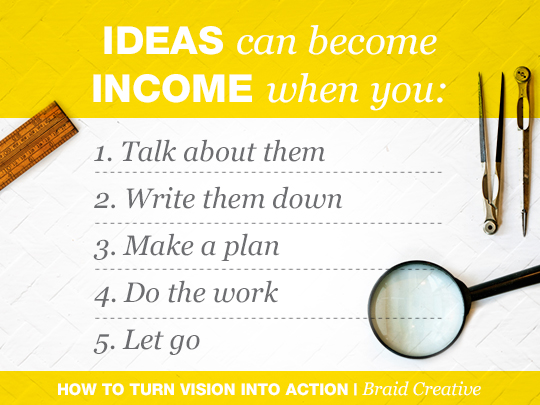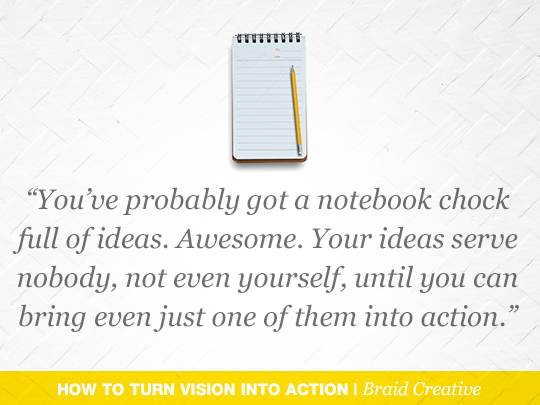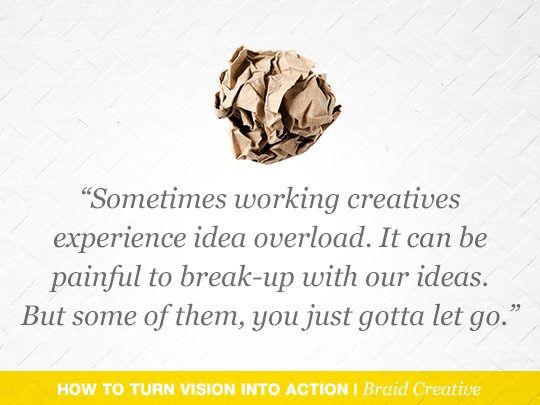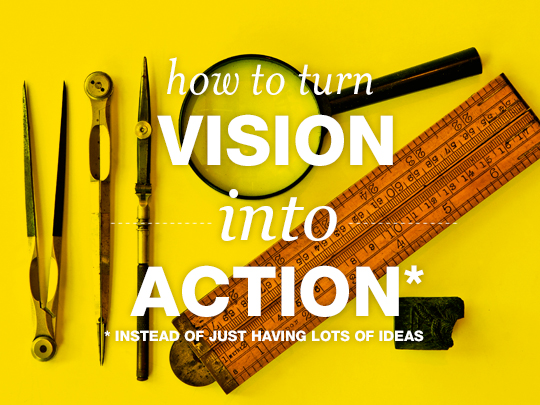The difference between creatives who are able to make good money and those who aren’t is the ability to turn vision into action. Kathleen here, with a little tough love: having lots of good ideas is not enough to make you a successful creative. It’s par for the course and it’s simply what is expected of you. So today I want to talk a little bit about how to take your ideas, turn them into vision, and then step-by-step action to bring those brilliant ideas into lucrative fruition. And by lucrative fruition… I’m talking about a paycheck.

STEP 1: Talk about your ideas.
The first step to transforming a fleeting thought into a good idea is to talk about it. I suggest over dinner with your partner, spouse, or best friend. Or perhaps over coffee with a mentor. A good brainstorm can go a long way in bringing an idea into reality. When talking about your idea allow yourself to go on tangents – give yourself permission to follow your train of thought wherever it wants to go. And by talking it out, especially with someone who can offer another perspective, you will be able to connect dots that will make your concept even better than your original idea.
STEP 2: Write it down.
Talking about an idea is the equivalent to flirting with it. Writing down your ideas brings commitment to them. The act of writing down your ideas, I’m talking pen to paper, is crucial to turning ideas into vision. What’s the difference between idea and vision? Vision is an idea with an action plan.
Try making lists, creating mind-maps, or even write a stream-of-consciousness braindump about your idea. Consider all the working parts of your idea and let it flow from your brain to your hand and out of your pen and into your notebook.

STEP 3: Make an action plan.
Now you’ve probably got a notebook chock full of ideas. Awesome. Start considering which one you’d like to bring to life. Your ideas serve nobody, not even yourself, until you can even bring just one of them into action. So now it’s time to create a plan of attack.
I’ve found that there are two solid ways of designing a game plan – either by starting from the very beginning and considering the first smallest step you can take. Or you can start at the end where the idea is a total success and work backwards from there. The point is to fill out all the steps that take you from beginning to end (or end to beginning), create actions to fulfill those steps, and hold yourself accountable with dates to complete those actions by.
STEP 4: Put Your Nose to the Grindstone
Alright, now you’ve got your action plan in place. All you need to do now is work through it step-by-step. Easier said than done so a few things to remember as you embark on turning your vision into action:
1. Give yourself permission to fail along the way. You’re going to get knocked down and thrown off course. That’s okay. No good story goes without a little bit of conflict. Your success depends on your ability to get back up and keep going.
2. Expect the unexpected. You’re going to hit roadblocks along the way – these are simply opportunities to rest, re-evaluate, tweak and adjust your plan accordingly. That’s right, your action plan isn’t set in stone – you can always change the trajectory of your idea.
3. Acknowledge the journey. It’s so easy to get frustrated when you have to fill the gap, step-by-little-step, between where you started and where you want to be. Recognize and acknowledge that the journey is a part of your creative process that makes your idea meaningful.
4. Share along the way. Create accountability for yourself by sharing your idea along the way. Blogging about it is a great way to maintain momentum.

STEP 5: Know when to let go.
Our client Rochelle recently experienced idea overload and went through a painful break-up with some of her ideas. She wrote about it here and I couldn’t be more proud of her for recognizing knowing when to let go of some of her amazing ideas that were leaving her feeling scattered and diffused. If taking action on your idea leaves you feeling energetically drained then it’s probably time to let the idea go. Or at least shelve it until you’re capable and ready to see it through.

